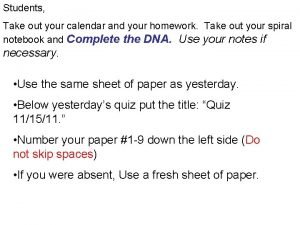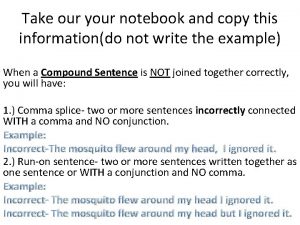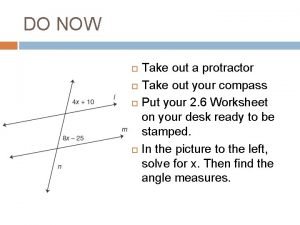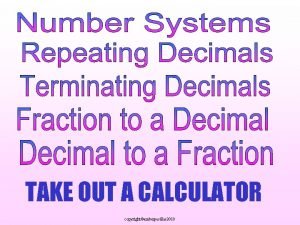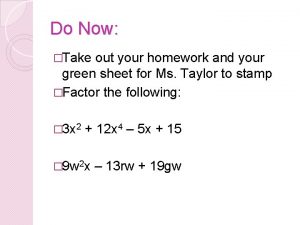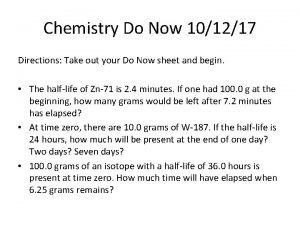Do Now 102219 n Take out your HW























- Slides: 23

Do Now 10/22/19 n. Take out your HW from last night. ¨Text n. Copy p. 117, #5 -16 all, 18 -24 evens, 33, 34, 36, 38 HW in your planner. ¨Text p. 125, #4 -30 evens, not 24 but 23. ¨Quiz sections 3. 1 -3. 3 Thursday 36 49 64 81

A runners speed is 5 mph. The number m of miles run is a function of the number h of hours spent running. Find the domain of the function. Is the domain discrete or continuous? Graph the function using its domain. The domain is h ≥ 0. It is continuous because it is any value greater than 0.

The linear function y = 1. 25 x represents the cost y (in dollars) of x bottles of orange juice. Each customer can buy a maximum of five bottles. Find the domain of the function. Is the domain discrete or continuous? Graph the function using its domain. The domain is 0, 1, 2, 3, 4, & 5. It is discrete because the number of bottles must be a whole number.

Homework Text p. 117, #5 -16 all, 18 -24 evens, 33, 34, 36, 38

Homework Text p. 117, #5 -16 all, 18 -24 evens, 33, 34, 36, 38

Homework Text p. 117, #5 -16 all, 18 -24 evens, 33, 34, 36, 38

Homework Text p. 117, #5 -16 all, 18 -24 evens, 33, 34, 36, 38

Learning Goal n SWBAT identify, write, graph, and transform linear functions Learning Target l SWBAT use function notation to evaluate functions and graph and solve functions

Section 3. 3 “Function Notation” Function Notationa linear function written in the form y = mx + b where y is written as a function f. x-coordinate This is read as ‘f of x’ f(x) = mx + b slope y-intercept f(x) is another name for y. It means “the value of f at x. ” g(x) or h(x) can also be used to name functions

Linear Functions What is the value of the function f(x) = 3 x – 15 when x = -3? A. -24 B. -6 C. -2 f(-3) = 3(-3) – 15 Simplify f(-3) = = -9 – 15 -24 D. 8

Linear Functions For the function f(x) = 2 x – 10, find the value of x so that f(x) = 6. f(x) = 2 x – 10 Substitute into the function 6 = 2 x – 10 Solve for x. 8 = x When x = 8, f(x) = 6

On Your Own Evaluate f(x) = 2 x – 7 when x = 4? f(4) = 2(4) – 7 Simplify For find the value of x for which g(x) = -4. (-4) = 1/3 x – 2 f(4) = 8 – 7 -2 = 1/3 x f(4) = 1 -6 = x When x = 4, f(x) = 1 When x = -6, g(x) = -4

Interpreting Function Notation

Domain and Range n Domain = values of ‘x’ for which the function is defined. n Range = the values of f(x) where ‘x’ is in the domain of the function f. n The graph of a function f is the set of all points (x, f(x)).

Graphing a Function To graph a function: ¨ (1) make a table by substituting into the function. ¨ (2) plot the points from your table and connect the points with a line. ¨ (3) identify the domain and range, (if discrete)

Graphing a Function y = 4 – 2 x with Graph the function the domain -2, -1, 0, 1, and 2. Then identify the range of the function. y-axis 10 (-2, 8) x y -2 8 -1 0 6 4 1 2 2 0 The range of the function is discrete and is 0, 2, 4, 6, 8. 8 (-1, 6) 6 4 (0 , 4 ) -12 -10 -8 x-axis -6 -4 -2 (1 , 2 ) 2 0 2 -2 -4 -6 -8 -10 4 (2 , 0 ) 6 8 10 12

Graphing a Function Graph the function f(x) =3/2 x – 2. y-axis 10 x 8 y -4 -8 -2 -5 0 -2 2 1 4 4 The graph is continuous because there are no restrictions on the domain. 6 (4 , 4 ) 4 2 -10 -8 x-axis -6 -4 -2 (0, -2) 0 2 -2 -4 (-2, -5) (-4, -8) -6 -8 -10 (2 , 1 ) 4 6 8 10 12

Graphing a Function Graph the function f(x) = 2 x – 3 SOLUTION STEP 1 STEP 2 Plot the points. Notice the points appear on a line. Connect the points drawing a line through them. Make a table by choosing a few values for x and then finding values for y. x -2 -1 0 f(x) -7 -5 -3 1 -1 2 1 STEP 3 The domain and range are continuous therefore, you do not have to identify.

Graphing a Function 1 – Graph the function f(x) = 2 x + 4 with domain x ≥ 0. Then identify the range of the function. STEP 1 x 0 2 4 6 8 Make a table. y 4 3 2 1 0 STEP 2 Plot the points. Connect the points with a ray because the domain is restricted. STEP 3 Identify the range. From the graph, you can see that all points have a y-coordinate of 4 or less, so the range of the function is y ≤ 4.

Graphing a Function Graph the function y = 2 x – 1 with domain – 2, – 1, 0, 1, and 2. Then identify the range of the function. SOLUTION STEP 1 Make a table by substituting the domain values into the function. STEP 2 List the ordered pairs: (– 2, – 5), (– 1, – 3), (0, – 1), (1, 1), (2, 3). Then graph the function. STEP 3 Identify the range. The range consists of the y-values from the table: – 5, – 3, – 1, 1, and 3.

Graph a Table In 1920 the ratification of the 19 th amendment to the United States Constitution gave women the right to vote. The table shows the number (to the nearest million) of votes cast in presidential elections both before and since women were able to vote. Years before or since 1920 – 12 – 8 – 4 0 4 8 12 Votes (millions) 15 15 19 27 29 37 40 a. Explain how you know that the table represents a function. b. Graph the function represented by the table.

Graph a function SOLUTION a. The table represents a function because each input has exactly one output. b. To graph the function, let x be the number of years before or since 1920. Let y be the number of votes cast (in millions).

Homework ¨ Text p. 125, #4 -30 evens
 One direction songs one thing
One direction songs one thing Take out your notebook
Take out your notebook Take out your homework
Take out your homework Take out your notebook
Take out your notebook Checked homework
Checked homework Friction
Friction Take out your homework
Take out your homework Take out your homework
Take out your homework Take out your notebook
Take out your notebook Take out your homework
Take out your homework Take out your notebook
Take out your notebook Take a point o on your notebook
Take a point o on your notebook Take out your homework
Take out your homework Take out your homework
Take out your homework Supranational organization examples
Supranational organization examples Take out your notebook
Take out your notebook Copy down in your notebook
Copy down in your notebook Take out your homework
Take out your homework Now i see it now you don't
Now i see it now you don't Take a bus or take a train
Take a bus or take a train Put your right foot in put your right foot out
Put your right foot in put your right foot out Grade 11 english answer key
Grade 11 english answer key Praise and honour unto thee
Praise and honour unto thee Medea notes
Medea notes













